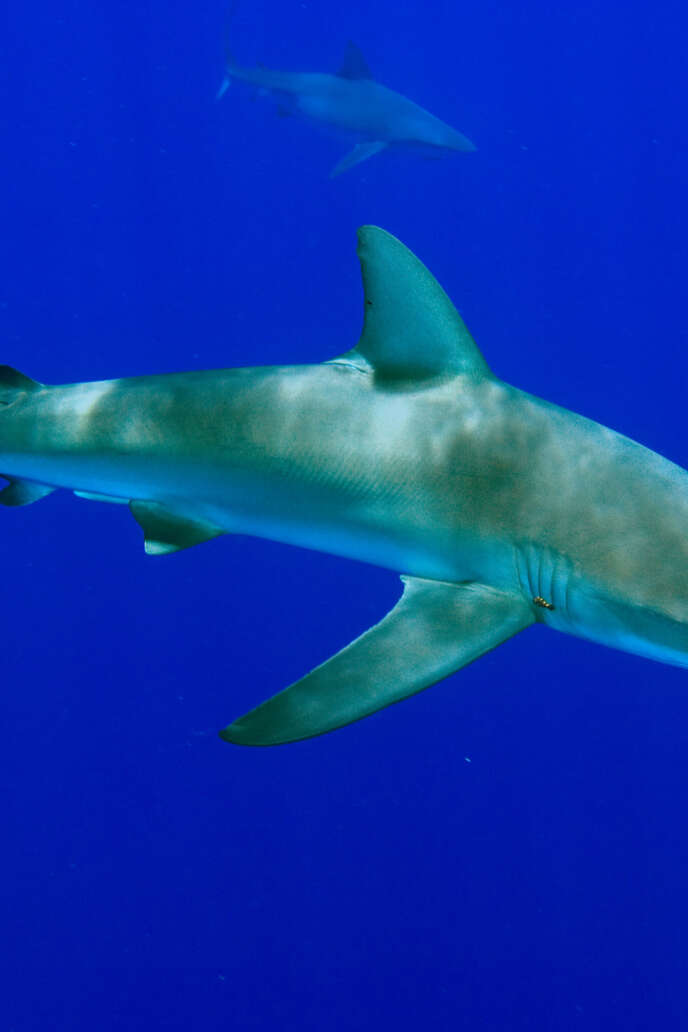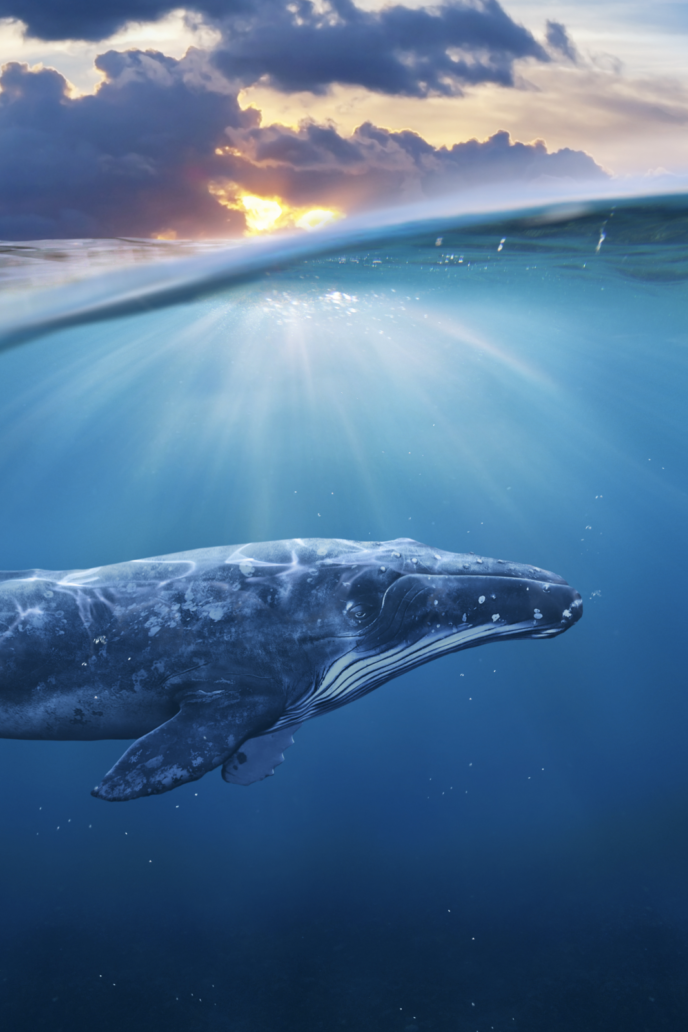Hawaii is a paradise of natural beauty, and its waters are no exception. From the crystal blue of the Pacific Ocean to the deep blues and greens of Hawaii’s lagoons, Hawaiian waters teem with life – including sharks! There are over 40 species of sharks that call Hawaiian waters home. While some may be rarer than others, here we will take a look at 10 of the most common types of sharks found in Hawaii. This list offers insight into what you might encounter when exploring offshore. So let’s dive in and discover more about these incredible predators!
1. Tiger Shark (Galeocerdo cuvier)
Hawaiian Name: niuhi
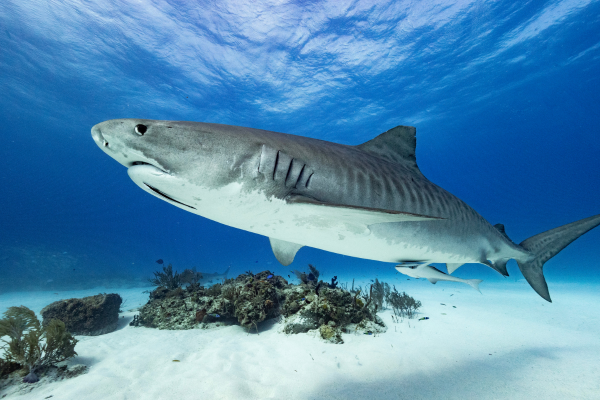
Anatomy
The Tiger Shark (Galeocerdo cuvier) can grow up to 18 feet in length and weigh up to 1,900 pounds, making it one of the largest species of shark. The body of a Tiger Shark is rather stout and muscular with a grayish-brown or olive color on its back and white on its underside. As they age, sharks develop a more blunt snout and curved serrated teeth. Younger sharks boast a striking spotting pattern which gradually turns into fading stripes as they grow older.
Population and Habitat
There are likely less than 250 adult sand tiger sharks left in the Mediterranean Sea. The International Union for Conservation of Nature has expressed concern over their declining population, which is believed to be caused by fishing, shark nets, and pollution.
Tiger sharks are versatile and can be found throughout coastal environments, from the surface to the bottom of the water column. In open ocean waters, they navigate between the surface and depths of approximately 2,500 ft. These sharks have extensive territories and are known to travel long distances, such as between the Main Hawaiian Islands and the Northwestern Hawaiian Islands. Each shark has its unique home range, which includes a core area that it frequents the most. Sometimes, the core areas of different sharks may overlap.
Diet and Common Predators
Tiger Sharks have quite a varied diet consisting of crustaceans, squid, sea turtles, fish, birds, and even marine mammals such as dolphins and whales. They are also known scavengers and will feed on carrion when available. Common predators such as Orcas (killer whales) have been known to hunt them but they do not pose a major threat to adult Tiger Sharks due to their size and strength.
2. Galapagos Shark (Carcharhinus galapagensis)
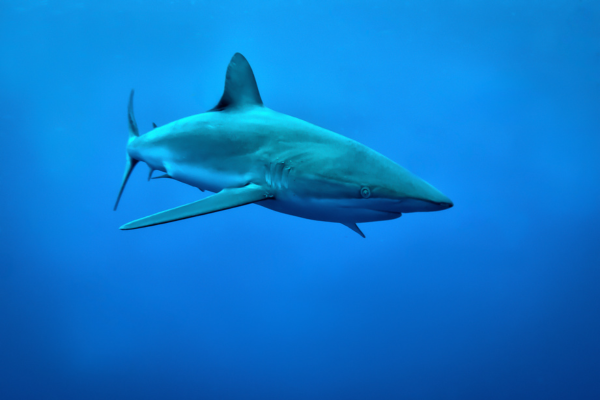
Anatomy
Galapagos Shark, also known as the gray reef whaler, can grow up to 12 ft long with a maximum of 9.8 ft reported in Hawaii. It has a wide, stout body with a short rounded snout, small eyes, and large triangular-shaped pectoral fins. Its coloration ranges from dark gray to light gray with whitish spots on its sides and fins.
Population and Habitat
The estimated global population is unknown but decreasing due to bycatch mortality, fishing pressures, habitat degradation, pollution, and climate change. The Galapagos Shark is currently listed as “near threatened” by the International Union for the Conservation of Nature and Natural Resources (IUCN). Galapagos Shark inhabits shallow coastal waters up to 82 ft (25 m) deep around reefs, algal beds, seagrass meadows, mangroves, bays, estuaries, and lagoons mostly in the Northwest Hawaiian Islands.
Diet and Common Predators
Its diet consists mainly of fish such as parrotfish, surgeonfish, grunts, and jacks; squid; octopus; crustaceans; polychaete worms; sea urchins; hermit crabs; stingrays; skates; sharks; sea turtles; dolphins; seals and sea lions—including adult harbor seals—are also potential prey items. Sharks such as tiger sharks are known predators of the Galapagos Shark but their predation pressure on them is low since they prefer different habitats than them.
3. Reef Shark (Carcharhinus melanopterus)
Hawaiian Name: manō pa’ele
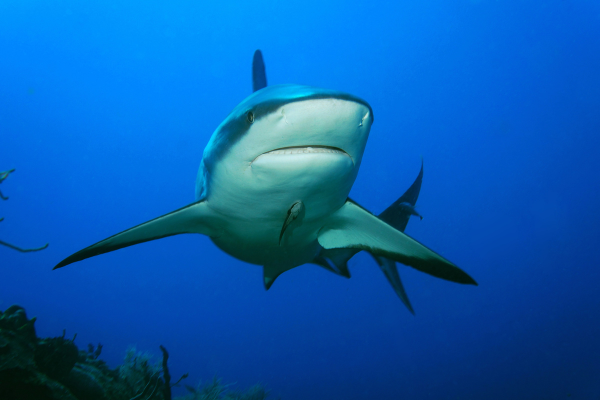
Anatomy
The Blacktip Reef Shark has a sleek, streamlined body with a pointed snout and a long, broad tail. They have characteristic black tips on their dorsal fins and their first dorsal fin is higher than the second. The average length is up to 6 feet but is generally under 5 feet. The color of the Blacktip Reef Shark varies from gray-brown to greenish-gray or bluish-gray on its back, fading to white on its underside. The light brown color is accentuated by bold, striking black marks on the first dorsal fin and lower tail tips. Notably, there is no inter-dorsal ridge present.
Population and Habitat
The exact population of Blacktip Reef Sharks in Hawaii is not known but are also considered near threatened. The Blacktip Reef Shark is found in tropical coral reefs around the world, particularly in Hawaii’s shallow lagoons and coastal waters. It can be found at depths ranging from the surface to 100 feet. It usually swims close to shore near sandy beaches. It can be seen near reefs as well as further offshore during whale migrations when large prey becomes available.
Diet and Common Predators
Its diet consists mainly of fish like sardines, anchovies, mullet, mackerels, barracuda, and tuna but will also feed on crustaceans such as crabs and shrimp if available. Its predators include larger sharks such as tiger sharks and bull sharks as well as dolphins and humans who hunt them for food or sport.
4. Gray Reef Shark (Carcharhinus amblyrhynchos)
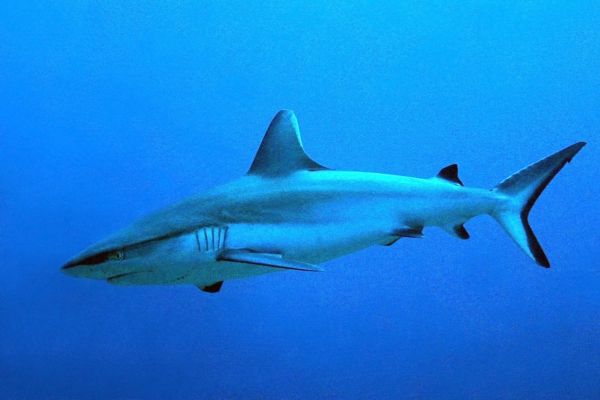
Anatomy
The Gray Reef Shark can grow to an average length of up to 8 feet, with the highest reported measurement being 6.2 feet in Hawaii, and can weigh around 200 pounds. The gray color of this fish is complemented by a subtle white streak along the edge of its dorsal fin. It also has a white belly and a slender, streamlined body that gives it great agility and speed in the water. Its tail has a prominent black margin, making it easily visible. Interestingly, this fish does not have an inter dorsal ridge.
Population and Habitat
The Gray Reef Shark population off Hawaii is believed to be healthy as there have been no reports of overfishing or significant population declines. However, they are vulnerable to accidental capture in fishing gear such as longlines and driftnets which can result in their mortality. These remarkable creatures are found at depths ranging from the surface to 900 ft, with their highest abundance observed at 320 ft. They are primarily concentrated in the Northwestern Hawaiian Islands. When it comes to their preferred habitat, Hawaiian records are known to thrive in reef areas with rugged terrain and strong currents.
Diet and Common Predators
These sharks are generally solitary creatures but will often form large groups when chasing prey. They are mainly found in shallow tropical and subtropical waters near coral reefs, lagoons, and bays where they can feed on small fish, squid, crustaceans, and other marine invertebrates. In addition to human-related threats, these sharks are preyed upon by larger predators such as Tiger Sharks and Great Hammerhead Sharks. Therefore we need to ensure that we protect their habitats so they can continue to thrive off the coast of Hawaii for many years to come.
5. Sandbar Shark (Carcharhinus plumbeus)
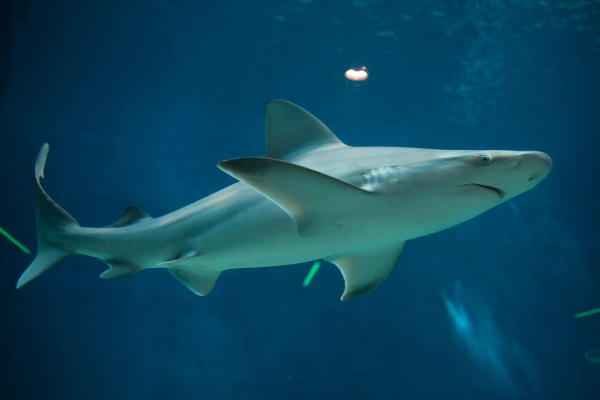
Anatomy
Sandbar Shark, also known as the “brown shark” or “ground shark,” is a large species of requiem shark. The sandbar shark’s anatomy includes a robust body, with two dorsal fins of approximately equal size, an interdorsal ridge, and very large pectoral fins that form almost half of the total length. It has a gray-brown coloration that allows it to blend in easily with its environment. Sandbar sharks range in size up to 8 ft. in length and weigh between 70-210 kgs.
Population and Habitat
The sandbar shark population in Hawaii is classified as Near Threatened by the International Union for Conservation of Nature (IUCN). This is due to overfishing for its meat, liver oil, fins, and hide which have been harvested for decades by humans; however current fishing regulations are helping recover this species’ population in the Hawaiian Islands.
They are found primarily in shallow waters along continental shelves and near river mouths around subtropical islands and coasts around the world. Females prefer shallower areas and typically cruise at an average depth of 223 ft, ranging from approximately 30 to 900 ft. In Hawaii, they are typically found on shallow reefs, sandy flats, and channels between sandbars.
Diet and Common Predators
The diet of the sandbar shark consists mainly of bony fish such as tuna, herring, mackerel, and salmon as well as invertebrates like squid and octopus. In Hawaii, they also feed on monkfish and lobsters near reef areas. Predators of the sandbar shark include larger sharks such as tiger sharks and great white sharks as well as marine mammals like orcas and seals which inhabit Hawaiian waters.
6. Scalloped Hammerhead Shark (Sphyrna lewini)
Hawaiian Name: manō kihikihi
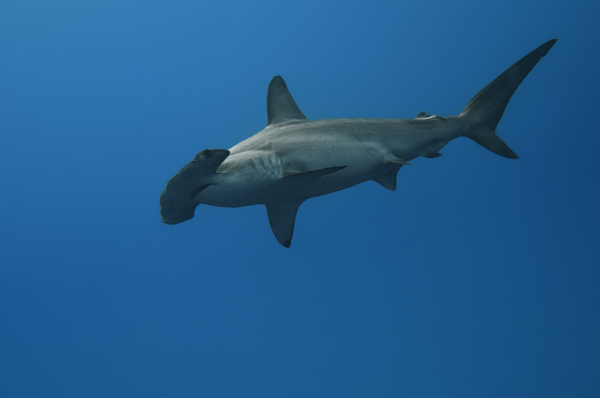
Anatomy
The scalloped hammerhead shark has a unique head shape, earning its name from its distinct “hammer”-shaped head, featuring a noticeable central indentation. This creature typically measures up to 14 feet in length, but generally, it is under 7 feet. It has two dorsal fins, small pectoral fins, and an asymmetrical caudal fin. It is a large species of shark that can weigh up to 550 kg. Its body is gray-brown with some yellowish hues on the underside and its head shows shades of light to dark brown.
Population and Habitat
In Hawaiian waters, populations of the scalloped hammerhead shark have been largely affected by overfishing and habitat destruction. Its range is mainly found in shallow tropical waters within Hawaii but it can also be found in pelagic habitats beyond the continental shelf. Adults migrate from offshore locations to the shallower waters of Hilo Bay, Kaneohe Bay, Waimea Bay, and other areas in Hawaii to give birth to their young. These juveniles are then monitored and it has been observed that those in Kaneohe Bay tend to stay close to the deeper areas near the bottom.
Diet and Common Predators
The scalloped hammerhead shark feasts on a variety of marine life including reef fishes, sharks, rays, cephalopods, and crustaceans. Its predators include other large sharks such as tiger sharks and great white sharks.
7. Smooth Hammerhead Shark (Sphyrna zygaena)
Hawaiian Name: manō kihikihi
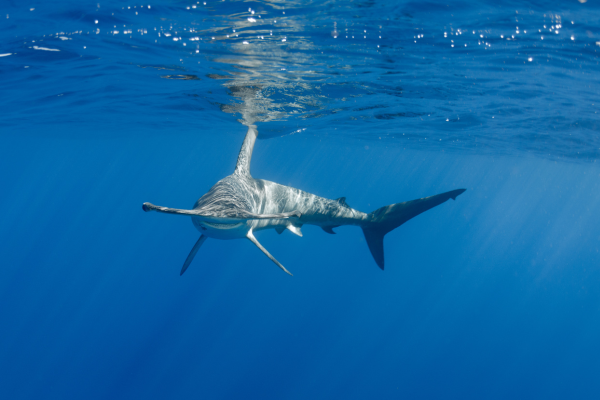
Anatomy
The Smooth Hammerhead Shark is characterized by its flat head with projecting eyes on the sides, and its long flattened snout shaped like a hammerhead. The head does not have a median indentation. They have a grayish-brown back, fading to yellow or white on their underside. It can reach lengths of up to 13 feet but is usually found to be under 8 feet in size.
Population and Habitat
Their population size is not well known due to the difficulty of accurately estimating populations of wide-ranging species that live at depths beyond recreational diving limits. However, their population is believed to be decreasing due to overfishing for their fins and meat which are highly valuable for international markets. In Hawaii, they are most commonly found near the main islands, including Oahu, Maui, and Hawaii Island. Smooth Hammerheads inhabit reefs, shallow lagoons, and continental shelves throughout Hawaii’s oceanic waters from a few meters depth up to 130 meters deep (400 ft).
Diet and Common Predators
In Hawaiian waters, Smooth Hammerheads feed mainly on small fish such as anchovies and sardines as well as squid and crustaceans. They may also feed on smaller sharks such as the reef whitetip shark or scalloped hammerhead shark when available. Smooth Hammerheads are apex predators that have few natural predators in Hawaii apart from killer whales and larger sharks such as tiger sharks or bull sharks, which can sometimes attack them for food or territorial purposes.
8. White Tip Reef Shark (Triaenodon obesus)
Hawaiian Name: manō lalakea
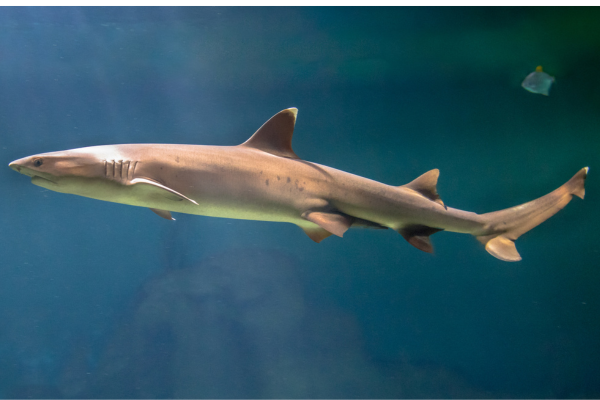
Anatomy
The White Tip Reef Shark has a wide, stout body with two dorsal fins and an anal fin. Its distinct shape helps it to quickly maneuver in coral reefs to capture prey. The White Tip Reef Shark is typically gray or brownish-gray in color with white tips on its fins. It has a flattened head and large eyes, enabling it to take advantage of low-light conditions when hunting for food. These creatures are small and typically measure under 5 feet in length, with a maximum length of 7 feet.
Population and Habitat
White Tip Reef Sharks do face some threats from humans such as illegal fishing activities like dynamite fishing, overfishing of their prey species, accidental entanglement in nets or lines intended for other fish species, and habitat loss due to coastal development or pollution. Currently, there is no accurate population estimate for this species but scientists believe that numbers have declined significantly in recent decades due mostly to human activities mentioned above.
White Tip Reef Sharks are widely distributed in tropical regions around the world, including much of the Hawaiian archipelago. In Hawaii, they tend to inhabit shallow reefs and lagoons near inshore areas, with some known to have ventured into deeper water from 25 to 130 feet. Sometimes, they even stay in these hidden retreats for extended periods.
Diet and Common Predators
These sharks are carnivorous predators that feed mainly on a variety of small fish, crustaceans, and cephalopods. They hunt mainly at night when their prey is more active and abundant in their environment. They also feed opportunistically upon dead animals as well as scavenging for food that may have been wounded by other predators such as barracudas or jacks.
9. Blacktip Shark (Carcharhinus limbatus)
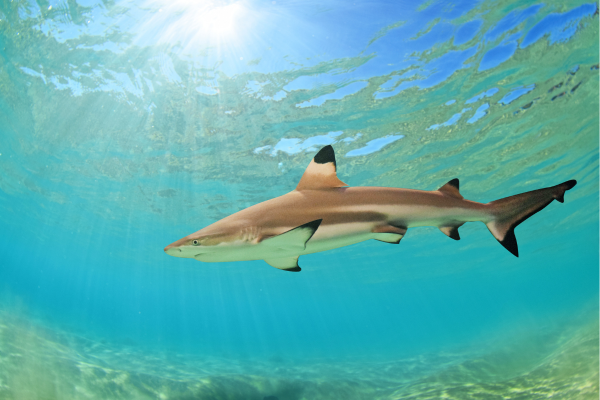
Anatomy
The Blacktip Shark ( is a species of requiem shark found in tropical and warm temperate waters worldwide. This fish has a gray body with black edges on its dorsal and pectoral fins. Its body is slender and streamlined, with a pointed snout and small eyes. It has long pectoral fins, which help to lift its body out of the water when swimming. The coloration is grayish or brownish on top with white on the underside of the body. Along its sides are distinct dark bands that form an alternating pattern with rows of pale spots above them. It can reach lengths of up to 8 feet.
Population and Habitat
The population numbers of the Blacktip Shark have decreased due to overfishing in some areas where they are highly sought after as gamefish, though their population status remains unknown globally due to a lack of research data in most regions where they are found.
Blacktip Sharks inhabit tropical and warm temperate waters around reefs as well as open ocean habitats such as lagoons, bays, and estuaries down to depths of around 210ft. They can also be found near continental shelves and occasionally even enter freshwater rivers close to shorelines if there is an opening from saltwater to freshwater bodies of water nearby. In Hawaii, they are found primarily off south-facing reefs such as those found off the Big Island’s Kona Coast or Maui’s Ka’anapali Coast, though they can be seen all around other Hawaiian Islands as well. Pups are also spotted from Kaneohe Bay to the breathtaking Midway Atoll
Diet and Common Predators
Blacktip Sharks feed mainly on fish but also eat crustaceans, cephalopods, mollusks, and even smaller sharks and rays when needed. They have been known to hunt cooperatively while following schools of prey fish like tuna or mackerel which helps them quickly locate food sources faster than alone. They also use their strong sense of smell to detect prey from both near and far distances underwater using special organs called ampullae of Lorenzini which aid in electroreception during hunting activities.
As apex predators at the top end of most marine food chains within their habitats, blacktip sharks play an important role in controlling populations below them by keeping some species from overpopulating while allowing others enough food resources to survive. Predatory threats for this species include larger sharks such as Tiger Sharks or Great White Sharks that may occasionally feed on juvenile blacktip sharks when encountered.
10. Bignose Shark (Carcharhinus altimus)
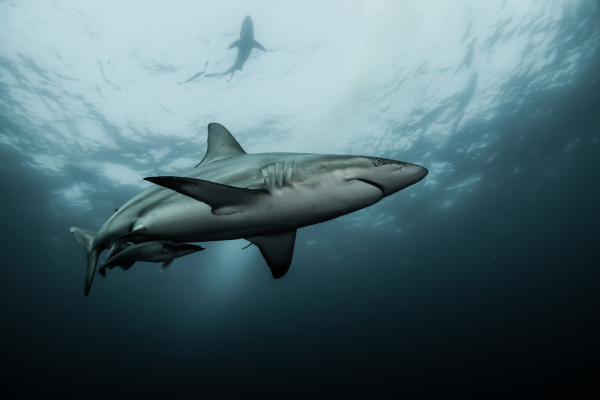
Anatomy
The Bignose Shark is named for its large snout, which has been known to reach up to 40% of the total length of the fish. The body of this species is stocky, with a short head and small eyes. The dorsal and lower lobe fins are sharply pointed and far apart from each other. The Bignose Sharks’ color varies greatly depending on the environment but typically includes various shades of gray or brown along the top, lighter gray or white along the sides and belly, and sometimes small black spots on the fins. They can reach an average length of 8-9 feet and average around 6 ft.
Population and Habitat
Bignose Sharks are not considered to be threatened globally due to their wide distribution range in tropical regions of the world’s oceanic basins; however, their population numbers have declined in some local areas due to overfishing or habitat destruction. As a result, they are considered “Near Threatened” by IUCN Red List standards and listed as “Protected” under Hawai’i state law since 2010 which prohibits fishing for them within three miles of shore without special permits from DLNR (Department of Land & Natural Resources).
In Hawaiian waters, these sharks are most commonly found in coastal areas around all the main islands including Kaho’olawe, Maui, Oahu, Kaua’i, Niʻihau, Molokai, and Hawaiʻi Island from about 90 to 1,200 ft.
Diet and Common Predators
Their preferred habitat consists of nearshore coral reefs where they feed on smaller fish such as mullets, grunts, jacks, and parrotfish. They are also known to take cephalopods occasionally such as squid or cuttlefish when available.
Bignose sharks are relentlessly pursued by humans as the ultimate predator. Their bodies are ruthlessly exploited for fish meal, animal feed, and oil production. However, take solace in knowing that such heinous practices are strictly prohibited within. Larger sharks also pose a menacing danger to their survival.
Wrap Up!
In conclusion, Hawaii’s rich marine landscape is home to a diverse array of sharks, each unique in its own right. These creatures contribute significantly to the ecological balance of the region. Understanding their behaviors and habitats can foster a sense of respect and conservation, ensuring these magnificent creatures continue to flourish in Hawaii’s waters for generations to come.



